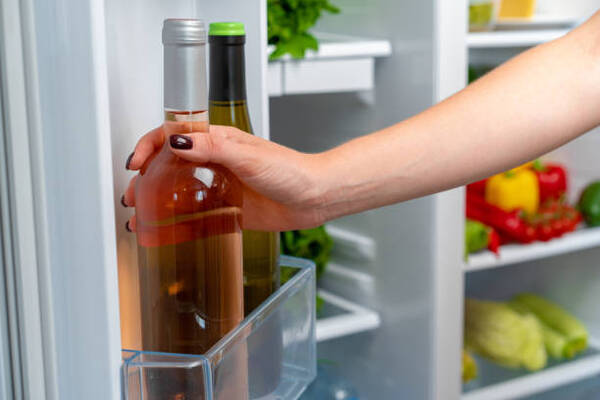- 1-905-452-8193
- Contact Us
- Member Login
- Get Listed Today
- 220,911 members

Wine should always be enjoyed at its optimal drinking temperature to ensure that it tastes as good as possible. If wine is too cold, then it will taste bitter or dull; however, if it's too warm, it will become unpleasant and flabby. Therefore, learning the perfect temperature for each type of wine ensures that no flavours are missed out on.
According to alcohol delivery Sydney owner Ming Lin, the quality of wine is hugely affected by the temperature at which it is stored. An understanding of why this is, and how different wines are affected, can help ensure they are stored in conditions that will maximize their potential flavour.
Keep the optimum quality of your wine longer by storing it at the right temperature.
What are the effects on colour?
Different grapes produce different colours of wine. Cooling red wines to temperatures below 5 degrees Celsius makes them appear paler in colour. This is because the chemical interactions during fermentation happen faster when grape juice reaches 10 degrees Celsius/50 degrees Fahrenheit or higher after having cooled from room temperature. These chemical reactions slow down as the liquid falls below 5 degrees Celsius so that no further reactions can take place within two weeks after fermentation has stopped. At these lower temperatures, the wine's colour is changed to something between pale pink and white.
Pale red wines undergo a similar change in temperature but due to reactions during fermentation rather than afterwards. The pigments responsible for creating red wine are anthocyanin and tannin compounds found in grape skins. Tannin-based anthocyanins require more time to develop at cooler temperatures while reacting quickly when they reach 10 degrees Celsius/50 degrees Fahrenheit or higher. Cooling these types of wines causes them to remain lighter in colour, producing a slightly more diluted taste with a greyer tint.
Red wines that have been cooled below 5 degrees Celsius will appear darker in colour. This only happens if the wine has been kept cool for an extended period. As the temperature drops, grape skins will release more tannins and anthocyanins into the wine giving it a darker colour. After two months at low temperatures, red wines typically take on a darker shade of red.
Although white wines do not undergo a physical change during an increase or decrease in temperature, there are chemical reactions that affect their flavour and taste as a result of this change. At cooler temperatures, these wines develop a greenish-yellow hue due to the absence of processing pigments known as carotenoids. To give whites their classic hint of yellow colour, they must be stored in warmer climates around 18 degrees Celsius/64 degrees Fahrenheit for at least three weeks serving them cold.
What are the effects on aroma?
Cooling wines to around 16 degrees Celsius/60 degrees Fahrenheit slows down the process of degradation caused by oxidation, which makes wines lose their fruity aromas. Every bottle also comes with a sulphur dioxide content. This is seen as an essential preservative in most wines but it dissipates at higher temperatures, often before the wine reaches its intended drinker. At lower temperatures though, this compound can remain long enough to enhance and conserve wine's fruity flavours for longer periods.
The opposite occurs when red wines are stored in warmer climates of between 20 and 22 degrees Celsius/68 and 72 degrees Fahrenheit, where the compounds that create their strong scents become more concentrated and intense. This is because heat speeds up the chemical reactions that break down these compounds into smaller parts, known as esters. In addition to creating a more pungent aroma, this process also dissolves some of the alcohol that is present in wine.
The effect on temperature has opposite effects for white wines. Low temperatures give them an alcoholic taste while exposure to warmer climates makes their flavours more subtle and refined. This is because at cooler temperatures there are fewer aromatic compounds available to create fruity aromas while exposure to warmer climates forces their breakdown giving off new scents of flowers, fruits, and even nuts.
Cooler temperatures will slow down both green apple—which gives the wine its sour scent—and vegetal aromas so they last longer than they would if wines were served in warmer climates.
Cooler regions create wines with more muted flavours—even when these grapes are perfectly ripe—in part because of the increased sugar content.
What are the effects on taste?
At lower temperatures, bitter acids will be much less noticeable in white wines while reds will have a slightly higher acidity level due to the chemical breakdown of thiol compounds. These are responsible for giving off blackcurrant or blackberry notes that disappear when the wine is stored in hotter climates. White wines also have longer-lasting tastes when they are kept cool because their fruity aromas do not fade as quickly. Alternatively, red wines become too sour when they are stored at cooler temperatures, and their high tannin levels break down into harsh notes.
When exposed to warmer climates, red wines too will begin to lose their fruity flavours which are replaced by more vegetal ones. This is because, at cooler temperatures, tannins bind together with anthocyanins and flavonoids in the grape skins but when this happens at higher temperatures they become much more bitter since they lack any binding compounds that would otherwise hold them together. White wines take on a stronger taste as well because of their heightened alcohol content.
Red wines develop an astringent taste when the temperature rises above 22 degrees Celsius/72 degrees Fahrenheit due to the concentration of tannin levels.
Wines are best served between 13-15 degrees Celsius/5559 degrees Fahrenheit for white wines and 18 degrees Celsius/64 degrees Fahrenheit for reds.
